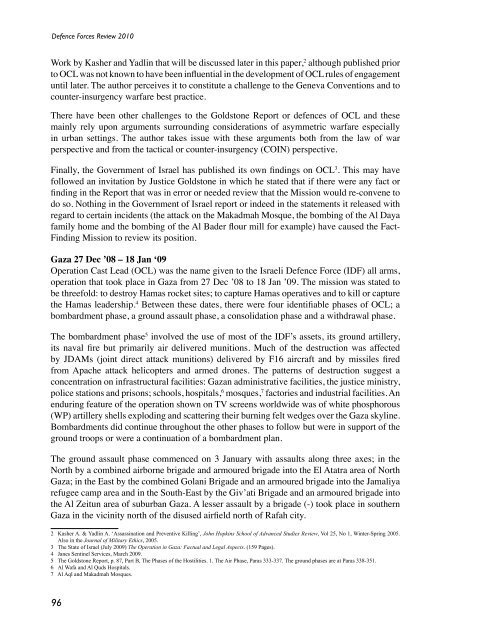Defence Forces Review 2010
Defence Forces Review 2010
Defence Forces Review 2010
You also want an ePaper? Increase the reach of your titles
YUMPU automatically turns print PDFs into web optimized ePapers that Google loves.
<strong>Defence</strong> <strong>Forces</strong> <strong>Review</strong> <strong>2010</strong>Work by Kasher and Yadlin that will be discussed later in this paper, 2 although published priorto OCL was not known to have been influential in the development of OCL rules of engagementuntil later. The author perceives it to constitute a challenge to the Geneva Conventions and tocounter-insurgency warfare best practice.There have been other challenges to the Goldstone Report or defences of OCL and thesemainly rely upon arguments surrounding considerations of asymmetric warfare especiallyin urban settings. The author takes issue with these arguments both from the law of warperspective and from the tactical or counter-insurgency (COIN) perspective.Finally, the Government of Israel has published its own findings on OCL 3 . This may havefollowed an invitation by Justice Goldstone in which he stated that if there were any fact orfinding in the Report that was in error or needed review that the Mission would re-convene todo so. Nothing in the Government of Israel report or indeed in the statements it released withregard to certain incidents (the attack on the Makadmah Mosque, the bombing of the Al Dayafamily home and the bombing of the Al Bader flour mill for example) have caused the Fact-Finding Mission to review its position.Gaza 27 Dec ’08 – 18 Jan ‘09Operation Cast Lead (OCL) was the name given to the Israeli <strong>Defence</strong> Force (IDF) all arms,operation that took place in Gaza from 27 Dec ’08 to 18 Jan ’09. The mission was stated tobe threefold: to destroy Hamas rocket sites; to capture Hamas operatives and to kill or capturethe Hamas leadership. 4 Between these dates, there were four identifiable phases of OCL; abombardment phase, a ground assault phase, a consolidation phase and a withdrawal phase.The bombardment phase 5 involved the use of most of the IDF’s assets, its ground artillery,its naval fire but primarily air delivered munitions. Much of the destruction was affectedby JDAMs (joint direct attack munitions) delivered by F16 aircraft and by missiles firedfrom Apache attack helicopters and armed drones. The patterns of destruction suggest aconcentration on infrastructural facilities: Gazan administrative facilities, the justice ministry,police stations and prisons; schools, hospitals, 6 mosques, 7 factories and industrial facilities. Anenduring feature of the operation shown on TV screens worldwide was of white phosphorous(WP) artillery shells exploding and scattering their burning felt wedges over the Gaza skyline.Bombardments did continue throughout the other phases to follow but were in support of theground troops or were a continuation of a bombardment plan.The ground assault phase commenced on 3 January with assaults along three axes; in theNorth by a combined airborne brigade and armoured brigade into the El Atatra area of NorthGaza; in the East by the combined Golani Brigade and an armoured brigade into the Jamaliyarefugee camp area and in the South-East by the Giv’ati Brigade and an armoured brigade intothe Al Zeitun area of suburban Gaza. A lesser assault by a brigade (-) took place in southernGaza in the vicinity north of the disused airfield north of Rafah city.2 Kasher A. & Yadlin A. ‘Assassination and Preventive Killing’, John Hopkins School of Advanced Studies <strong>Review</strong>, Vol 25, No 1, Winter-Spring 2005.Also in the Journal of Military Ethics, 2005.3 The State of Israel (July 2009) The Operation in Gaza: Factual and Legal Aspects. (159 Pages).4 Janes Sentinel Services, March 2009.5 The Goldstone Report, p. 87, Part B, The Phases of the Hostilities. 1. The Air Phase, Paras 333-337. The ground phases are at Paras 338-351.6 Al Wafa and Al Quds Hospitals.7 Al Aql and Makadmah Mosques.96
















